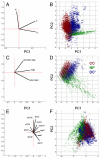Quantifying structure and performance diversity for sets of small molecules comprising small-molecule screening collections
- PMID: 21482810
- PMCID: PMC3084049
- DOI: 10.1073/pnas.1015024108
Quantifying structure and performance diversity for sets of small molecules comprising small-molecule screening collections
Abstract
Using a diverse collection of small molecules we recently found that compound sets from different sources (commercial; academic; natural) have different protein-binding behaviors, and these behaviors correlate with trends in stereochemical complexity for these compound sets. These results lend insight into structural features that synthetic chemists might target when synthesizing screening collections for biological discovery. We report extensive characterization of structural properties and diversity of biological performance for these compounds and expand comparative analyses to include physicochemical properties and three-dimensional shapes of predicted conformers. The results highlight additional similarities and differences between the sets, but also the dependence of such comparisons on the choice of molecular descriptors. Using a protein-binding dataset, we introduce an information-theoretic measure to assess diversity of performance with a constraint on specificity. Rather than relying on finding individual active compounds, this measure allows rational judgment of compound subsets as groups. We also apply this measure to publicly available data from ChemBank for the same compound sets across a diverse group of functional assays. We find that performance diversity of compound sets is relatively stable across a range of property values as judged by this measure, both in protein-binding studies and functional assays. Because building screening collections with improved performance depends on efficient use of synthetic organic chemistry resources, these studies illustrate an important quantitative framework to help prioritize choices made in building such collections.
Conflict of interest statement
The authors declare no conflict of interest.
Figures





References
-
- Iwasa J, Fujita T, Hansch C. Substituent constants for aliphatic functions obtained from partition coefficients. J Med Chem. 1965;8:150–153. - PubMed
-
- Fujita T, Hansch C. Analysis of the structure-activity relationship of the sulfonamide drugs using substituent constants. J Med Chem. 1967;10:991–1000. - PubMed
-
- Hansch C. A quantitative approach to biochemical structure-activity relationships. Acc Chem Res. 1969;2:232–239.
-
- Clemons PA. Chemical Informatics. In: Schreiber SL, Kapoor TM, Wess G, editors. Chemical Biology: From Small Molecules to Systems Biology and Drug Design. Vol 2. Weinheim Germany: Wiley-VCH; 2007. pp. 723–759.
-
- Drewry DH, Macarron R. Enhancements of screening collections to address areas of unmet medical need: An industry perspective. Curr Opin Chem Biol. 2010;14:289–298. - PubMed
Publication types
MeSH terms
Grants and funding
LinkOut - more resources
Full Text Sources
Other Literature Sources

